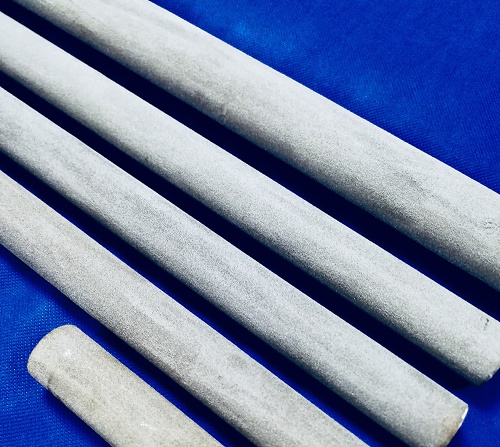Lord Fin Tube-Sintered High Flux Tubes
Sintered High Flux Tubes
High Flux Tubes are capable of largely enhancing heat transfer efficiency in the nucleate boiling regime. A porous metal layer or matrix is bonded metallurgically to the heat-transfer surface. Saturated liquid is drawn into the layer by capillary action and vaporizes from the extremely large number of stable generation sites which exist in the structure. Boiling side heat transfer coefficients of 10-30 times that of bare tubes can be achieved, resulting in an overall heat transfer improvement of 2-4 times that of bare tubes. They exist another excellent feature that the tubes are not prone to fouling due to the extremely active boiling surface.
The use of High Flux tubes allows reduced exchanger surface area and/or lower utility consumption, resulting in substantial savings in capital and operating costs.
High Flux Tubes
High Flux Tubes are capable of largely enhancing heat transfer efficiency in the nucleate boiling regime. A porous metal layer or matrix is bonded metallurgically to the heat-transfer surface. Saturated liquid is drawn into the layer by capillary action and vaporizes from the extremely large number of stable generation sites which exist in the structure. Boiling side heat transfer coefficients of 10-30 times that of bare tubes can be achieved, resulting in an overall heat transfer improvement of 2-4 times that of bare tubes. They exist another excellent feature that the tubes are not prone to fouling due to the extremely active boiling surface.
The use of High Flux tubes allows reduced exchanger surface area and/or lower utility consumption, resulting in substantial savings in capital and operating costs. For large reboiler duties, the use of High Flux tubes can reduce the total number of exchanger shells required, resulting in not only reduced exchanger costs but savings in piping, controls, foundation, and plot plan space.
In retrofit situations, the use of High Flux tubes in existing exchanger shells can allow increased capacity and/or elimination of a new exchanger addition. Alternatively, the use of High Flux Tubes can allow the use of lower pressure steam at fixed capacity, reducing utility costs. In a revamp situation, the use of High Flux Tubes, as an alternative to a new exchanger, is particularly attractive due to conservation of plot space, minimum downtime, and short lead-times.
Stable boiling is achievable at low temperature differentials. This feature can be used minimize the Log Mean Temperature Difference (LMTD) of the heat exchanger to reduce utility consumption. This is particularly effective in heat pump applications by reducing the compressor demand.
High Flux Tubes can be either ID or OD coated for boiling on the tube side or shell side, and the non-coated side can be finned or fluted by extrusion process for additional heat transfer capacity.
Sintered High Flux Tubes Typical application:
Heat-pumped propylene/isobutene fractionators
Ammonia plant synthetic gas chilling applications.
Grassroots heavy aromatics separation,
Natural gas de-ethanizing
Sintered High Flux Tube type:
No.1:Coated ID surface + Fluted OD surface, coated length 6000mm OD: 31.75mm
No.2:Fluted ID surface + Coated OD surface, coated length 14000mm OD: 19.25mm, 31.75mm
No.3: Coated ID surface only, coated length 6000mm OD: 31.75mm
No.4: Coated OD surface only, coated length 14000mm OD: 19.25mm, 31.75mm
Other sizes are available on request, Metric or Imperial system measurement is available on request
Sintered High Flux Tubes base tube material:
Copper nickel 90/10, UNS C70600 as per ASME SB111, Low-carbon steel, SAE1010 as per ASME SA179, Other materials such as stainless steels, nickel is available on request
The high flux tube is hydrostatic tested before delivery
The inspection by any third party is agreeable


